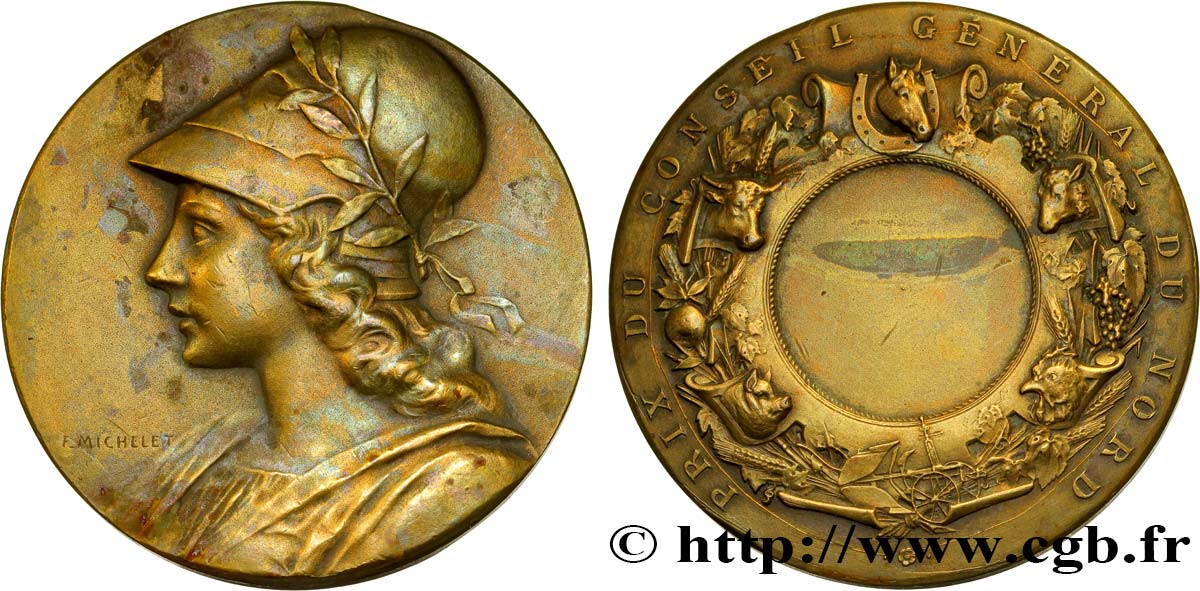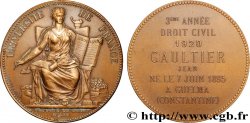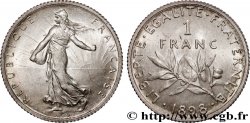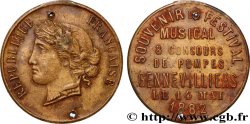E-auction 261-184486 - fme_367374 - III REPUBLIC Médaille - Prix du conseil général du Nord
You must signin and be an approved bidder to bid, LOGIN TO BID. Accounts are subject to approval and the approval process takes place within 48 hours. Do not wait until the day a sale closes to register. Clicking on « bid » constitutes acceptance of the terms of use of cgb.fr private e-auctions.
Bids must be placed in whole Euro amounts only. The sale will start closing at the time stated on the item description; any bids received at the site after the closing time will not be executed. Transmission times may vary and bids could be rejected if you wait until the last second. For further information ckeck the E-auctions F.A.Q.
NO BUYER'S FEE.
NO BUYER'S FEE.
| Estimate : | 75 € |
| Price : | 17 € |
| Maximum bid : | 113 € |
| End of the sale : | 16 April 2018 18:43:30 |
| bidders : | 4 bidders |
Type : Médaille - Prix du conseil général du Nord
Date: n.d.
Mint name / Town : 58 - Lille
Metal : bronze
Diameter : 50 mm
Orientation dies : 12 h.
Engraver MICHELET Firmin (1875-1951)
Weight : 57 g.
Edge : lisse + BRONZE
Coments on the condition:
Médaille en bon état avec de beaux reliefs mais une patine un pu hétérogène au droit avec une tache en longueur au revers
Obverse
Obverse legend : ANÉPIGRAPHE.
Obverse description : Buste féminin à gauche, coiffée d’un casque corinthien orné d’une branche de lauriers.
Reverse
Reverse legend : PRIX DU CONSEIL GÉNÉRAL DU NORD.
Reverse description : Cartouche circulaire entouré d’une couronne mêlant des gerbes de blé, de la vigne, des pommes ; des têtes de bélier, boeuf, cheval, coq et porc.
Commentary
Médaille non attribuée avec un cartouche en réserve non gravé.
Marcelin Firmin Michelet, né le 20 septembre 1875 à Tarbes, commune où il est mort le 14 octobre 1951, est un sculpteur et artiste graveur français. Il s'illustra surtout dans le domaine de la statuaire monumentale, mais aussi dans la médaille et les monnaies (avec la série de monnaies de nécessité de Tarbes).
Il se forma auprès des sculpteurs toulousains Falguière, Mercié et Marqueste. Membre de la Société des artistes français, il exposa aux Salons des artistes français, d'Automne et des Tuileries à partir de 1898. Il réalisa tout au long de sa carrière officielle récompensée par de nombreux prix, de très nombreux monuments publics et commémoratifs, excellant dans le domaine de la statuaire monumentale.
Il exécuta pour Tarbes le Monument au Souvenir des enfants des Hautes-Pyrénées morts pour la France et la statue équestre du Maréchal Foch. Il a également réalisé un nombre important de monuments aux morts dans le département des Hautes-Pyrénées. On lui doit également celui du Collège Stanislas.
Cet artiste méconnu fut également l'auteur, à côté de Paul Belmondo et quelques autres, d'un bas-relief du Palais du Trocadéro. De même, on peut voir de lui de nombreuses sculptures réalisées après la Première Guerre mondiale à la chapelle commémorative du Mémorial des batailles de la Marne. Il immortalisa les traits du Maréchal Foch, tarbais comme lui, par un buste, deux statues de pied et une statue équestre.
Le Musée d'Orsay conserve aussi quelques-unes de ses œuvres..
Marcelin Firmin Michelet, né le 20 septembre 1875 à Tarbes, commune où il est mort le 14 octobre 1951, est un sculpteur et artiste graveur français. Il s'illustra surtout dans le domaine de la statuaire monumentale, mais aussi dans la médaille et les monnaies (avec la série de monnaies de nécessité de Tarbes).
Il se forma auprès des sculpteurs toulousains Falguière, Mercié et Marqueste. Membre de la Société des artistes français, il exposa aux Salons des artistes français, d'Automne et des Tuileries à partir de 1898. Il réalisa tout au long de sa carrière officielle récompensée par de nombreux prix, de très nombreux monuments publics et commémoratifs, excellant dans le domaine de la statuaire monumentale.
Il exécuta pour Tarbes le Monument au Souvenir des enfants des Hautes-Pyrénées morts pour la France et la statue équestre du Maréchal Foch. Il a également réalisé un nombre important de monuments aux morts dans le département des Hautes-Pyrénées. On lui doit également celui du Collège Stanislas.
Cet artiste méconnu fut également l'auteur, à côté de Paul Belmondo et quelques autres, d'un bas-relief du Palais du Trocadéro. De même, on peut voir de lui de nombreuses sculptures réalisées après la Première Guerre mondiale à la chapelle commémorative du Mémorial des batailles de la Marne. Il immortalisa les traits du Maréchal Foch, tarbais comme lui, par un buste, deux statues de pied et une statue équestre.
Le Musée d'Orsay conserve aussi quelques-unes de ses œuvres..








 Report a mistake
Report a mistake Print the page
Print the page Share my selection
Share my selection Ask a question
Ask a question Consign / sell
Consign / sell
 Full data
Full data









